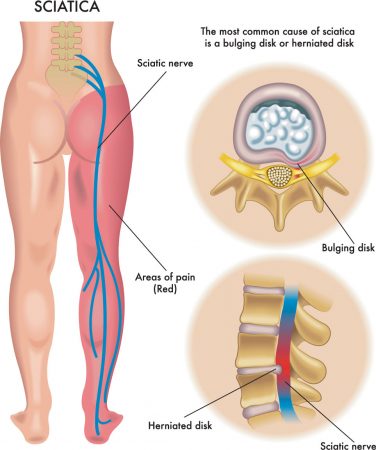Sciatica is a common painful condition that is characterized by pain in the lower back and gluteal region. The sciatic nerve runs from the lower back (lumbar) through the hips and down each leg. The pain varies in intensity and frequency, usually radiating down one or both legs into the buttock, thigh, calf, ankle, and foot, and can be described as sharp, dull, burning, tingly, numb, continuous, or intermittent. In some cases, sciatic nerve compression may be so severe that it can result in the loss of feeling or even paralysis of a single limb.
Sciatica
What Causes Sciatica?
Sciatic pain is most often the result of herniated/bulging discs, and results when the base of the spine is compressed or when injury has compacted the spinal roots of the sciatic nerve. In most circumstances, sciatica affects only one side of the body at a time. Other conditions that may cause sciatica include spinal stenosis (narrowing of the spinal canal in the lower back), spondylolisthesis (one vertebra slips forward over another one), pregnancy and childbirth, bone spurs, tumors in the spine, and nerve damage from diabetes.
Since there are many factors that can cause sciatica the proper diagnosis is essential. Sciatica is usually diagnosed based on a person’s symptoms and through diagnostic testing of an x-ray, MRI, CT scan and/or electrodiagnostic tests to look for herniated discs, bone spurs, or other problems in the spine. However, before testing is performed, a chiropractor will first do a review of the patient’s medical history, and a physical and neurological examination.

Chiropractic Care Can Do Wonders for Sciatic Pain
The purpose of chiropractic treatment for sciatic pain is to help the body heal itself. Not only is chiropractic care a non-invasive and drug-free treatment, but the adjustments will remove irritation from your nerves that cause sciatic pain.
The type of chiropractic treatments may vary depending on the cause of the patient’s sciatica. One patient may be given ultrasound and transcutaneous electrical nerve stimulation (TENS) while another patient may be given spinal adjustments to relieve the sciatic pain.

The Differences in Treatments…
- Ultrasound treatment – is heat created by sound waves that penetrates deep into tissues to increase circulation and help reduce muscle spasms and stiffness.
- TENS therapy – low-voltage electric pads that are placed on the body at the site of where the sciatic pain is to help alleviate discomfort.
- Spinal manipulation – the adjustments releases restricted movement of the spine and helps restore misaligned vertebral bodies to their proper position. It also helps reduce inflammation, muscle spasms, and other symptoms related to sciatica due to nerve irritability. The adjustments are not painful and are proven to be safe and effective.
- Ice pack therapy – reduces inflammation and helps control sciatic pain



